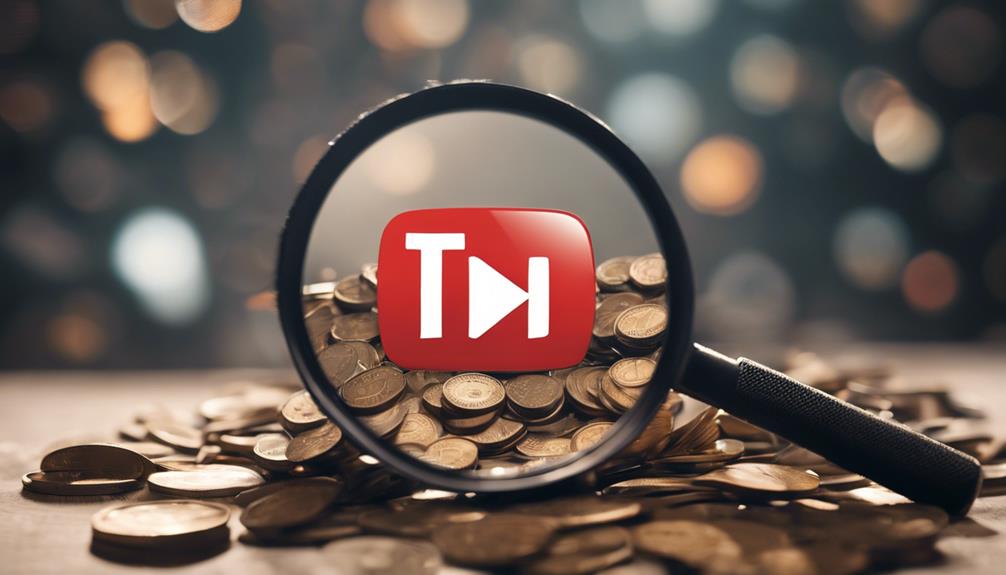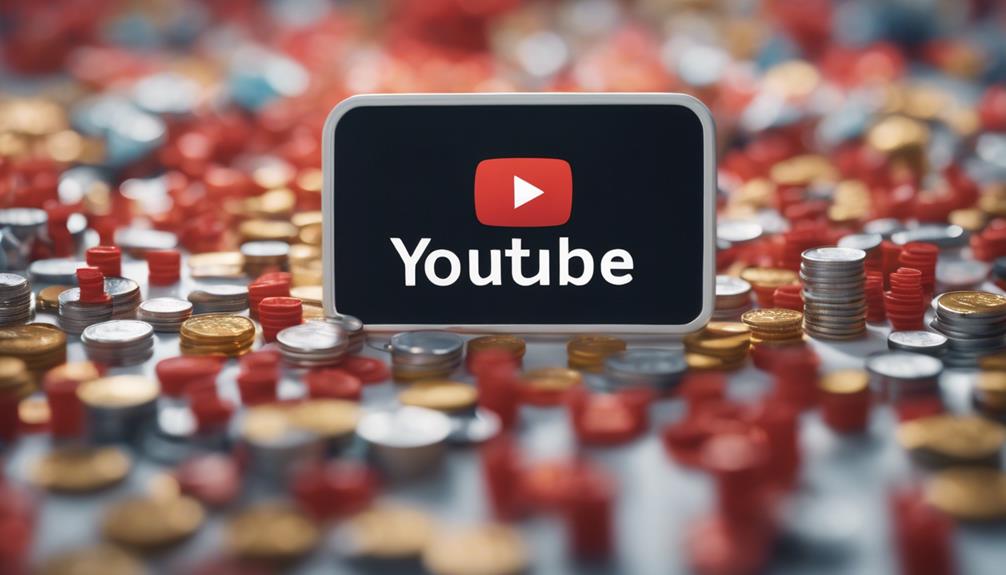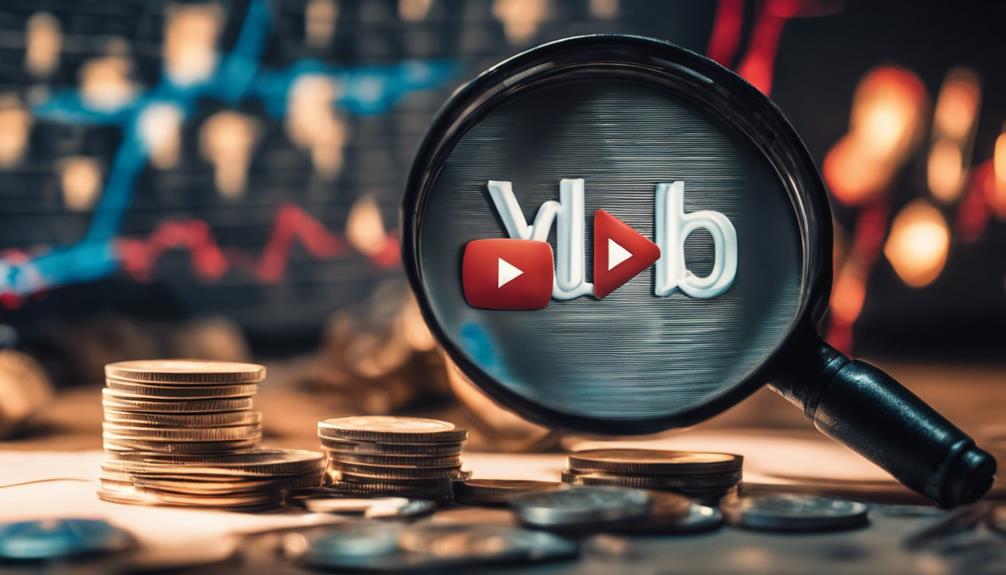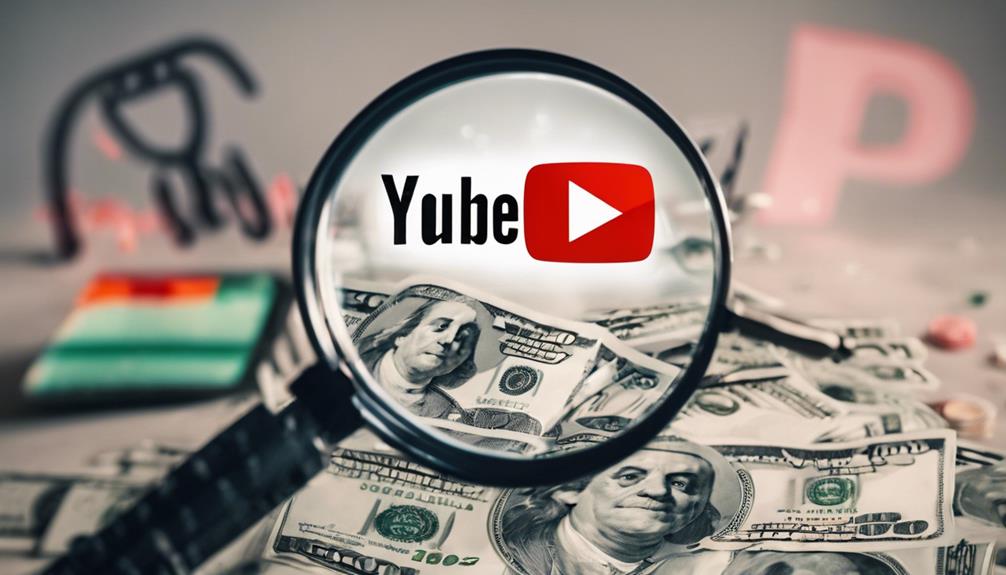
How much YouTube Shorts pay for 1,000 views?
While you might earn a decent paycheck from a traditional job, the digital world of YouTube Shorts is a different beast entirely.
You’re probably wondering how much you can earn for 1,000 views on these bite-sized videos. Well, the answer isn’t as straightforward as you might think.
It’s not just about the number of views; there are other factors at play. The type of ads, the viewer’s location, and even the content’s quality can influence your potential earnings.
Want to know more? Stick around, and let’s unravel this digital treasure chest together.
Key Takeaways
- The pay for 1,000 views on YouTube Shorts relies on variables like engagement metrics, viewer demographics, and ad demand.
- CPM, the amount advertisers pay for a thousand ad views, notably influences YouTube Shorts revenue.
- Geographic location of viewers and the types of ads displayed also impact earnings from YouTube Shorts.
- Despite misconceptions, CPM is not the sole revenue source, with alternatives like sponsorships and merchandise sales also contributing.
Understanding YouTube Shorts

To fully comprehend how much YouTube Shorts pay for 1,000 views, you need to first grasp the concept and functionality of YouTube Shorts, a newer, bite-sized video format on the platform. Launched to rival TikTok’s success, these snappy videos, no more than 60 seconds long, employ a vertical view, perfect for mobile consumption.
Now, let’s delve into the Shorts algorithm, the unseen force that drives content to viewers. YouTube’s algorithm is notoriously complex, analyzing vast amounts of data to predict what content a user may enjoy. In Shorts, this algorithm is fine-tuned for rapid consumption. It’s hyper-focused on user engagement- likes, shares, comments, and watch time. Your content strategy should aim to hook viewers in the first few seconds, hold their attention, and inspire engagement.
How YouTube Monetization Works
Understanding YouTube’s monetization process is crucial, as it’s the engine that fuels your potential earnings from Shorts. Monetization eligibility is the first hurdle to overcome. To qualify, you need a minimum of 1,000 subscribers and 4,000 watch hours in the past 12 months.
Joining the YouTube Partnership Program is the next step. This involves agreeing to YouTube’s terms and connecting an AdSense account. Once approved, you can start making money from your content.
Here’s a basic breakdown in a markdown table:
| Step | Details |
|---|---|
| Monetization eligibility | 1,000 subscribers and 4,000 watch hours |
| Apply for Partnership Program | Agree to YouTube’s terms |
| Connect an AdSense account | Link an existing or create a new AdSense account |
| Get approval | Wait for YouTube’s review and approval |
| Start earning | Monetize your content and start earning |
Always remember, the monetization process doesn’t guarantee profits. It’s a tool that enables you to potentially earn money. The real value is in the content you create and how well it resonates with your audience. Innovation, creativity, and understanding your audience are key.
The Role of Advertising

Now that you’re equipped with knowledge on YouTube’s monetization process, let’s explore the significant role advertising plays in generating revenue from your Shorts.
Simply put, advertisers pay to promote their products or services on your videos, offering a steady stream of income.
Advertiser preferences play a key role in this process. Your content needs to align with what advertisers are looking for. They’re drawn to channels that garner a substantial audience or those that cater to a specific niche, increasing the likelihood of conversions. That’s where content promotion comes into play. By promoting your content effectively, you can attract a larger audience, making your channel more attractive to advertisers.
Data from YouTube shows that channels that effectively target advertiser preferences and promote their content see an increase in ad revenue by 50%. Additionally, channels that maintain a consistent upload schedule and engage with their audience also see a noticeable increase in earnings.
Breaking Down CPM (Cost per Mille)
Let’s break down CPM, or cost per mille, and how it impacts your earnings from YouTube Shorts.
CPM is essentially the amount an advertiser pays for one thousand views of its ad, and it’s a crucial metric in determining your potential income.
Understanding CPM Concept
Diving into the concept of CPM, or Cost per Mille, it’s crucial to note it’s the amount an advertiser pays for one thousand views or clicks of an advertisement. This data-based metric is essential to understand the profitability of your YouTube Shorts.
Despite this, several misconceptions surround CPM, including:
- CPM being the only revenue source: There are alternatives like sponsorships, merchandise sales, and fan donations.
- All views count towards CPM: Not every view gets monetized due to factors like ad-blockers and viewer location.
- Higher CPM always means higher earnings: CPM doesn’t account for costs incurred in creating the content.
It’s vital to clarify these CPM Misconceptions and consider CPM Alternatives to maximize your YouTube Shorts earnings.
Impact on Youtube Shorts
To truly grasp the impact of CPM on your YouTube Shorts revenue, it’s essential to break down each component of this complex metric. CPM, or Cost per Mille, is the amount you’d earn for every thousand views. It’s influenced by factors such as viewer location, ad type, and content quality.
With the soaring popularity of Shorts, creators are facing stiff competition. The more engaging and unique your content, the higher your CPM can be. However, it’s not just about views. Viewer interaction, like likes, shares, and comments, also affect your CPM.
Maximizing CPM Earnings
Understanding how to maximize your CPM earnings requires a deep analysis of its components and the strategies that can effectively drive them up.
Exploiting the ‘ad placement strategy’ effectively, for instance, can boost your CPM. Here’s how:
- Strategically place ads where engagement is high, ensuring maximum visibility.
- Leverage mid-roll ads for longer videos, as they’ve higher CPMs.
- Experiment with different ad formats to find what works best for your content.
Further, you can’t overlook ‘algorithm manipulation’. Understanding YouTube’s algorithm and tailoring your content to its preferences can significantly increase your views and, subsequently, your CPM. Always remember, data-driven decisions are your best bet when it comes to maximizing your YouTube Shorts’ CPM earnings.
Factors Influencing YouTube Shorts Pay
You must understand that YouTube Shorts pay isn’t a flat rate; it’s influenced by several factors like revenue generation variables and viewer engagement.
For instance, the geographical location of your viewers, the type of ads displayed, and the overall engagement your videos receive can significantly impact your earnings.
It’s not just about the views, but a more complex interplay of these elements.
Revenue Generation Variables
What factors impact the amount of money you can earn from YouTube Shorts per 1,000 views? The answer lies in understanding key revenue generation variables.
First, platform algorithms play a critical role. YouTube’s systems, designed to reward creators that drive engagement, can either amplify or limit your content’s visibility, directly affecting your earning potential.
Viewer demographics: Advertisers pay more to target certain groups, impacting your revenue.
Video length and quality: Higher quality videos or those of optimal length may bring in more revenue.
Advertiser demand: The more advertisers willing to pay for ad space on your content, the higher your earnings.
Viewer Engagement Impact
Building on the importance of revenue generation variables, it’s crucial to analyze how viewer engagement significantly influences the payout for YouTube Shorts per 1,000 views. Audience retention and content virality are key indicators here.
| Factor | Impact |
|---|---|
| Audience Retention | A higher retention rate increases the likelihood of your content being recommended by YouTube’s algorithm, thereby increasing your views and potential earnings. |
| Content Virality | Viral content attracts more views. More views translate to higher earnings. |
| Viewer Interaction | Likes, shares, and comments can influence how YouTube’s algorithm ranks your content. Higher ranked content results in more views. |
| Viewer Demographics | Certain demographics may be more valuable to advertisers, affecting your earnings. |
| Content Quality | High-quality content enhances viewer engagement and can lead to higher earnings. |
Understanding these factors helps maximize your YouTube Shorts profitability.
Calculating Earnings: 1,000 Views

To calculate earnings from 1,000 views on YouTube Shorts, it’s essential to understand the intricacies of YouTube’s monetization policies and the variability in ad revenue rates. You mustn’t only be aware of your content’s viewership demographics but also stay up-to-date on the latest content trends.
These two factors – viewership demographics and content trends – are vital for the following reasons:
- Viewership demographics: The age, location, and interests of your viewers influence the ads served on your videos. Advertisers pay more to target certain demographics, meaning a higher cost per mille (CPM), thus more earnings for you.
- Content trends: Trending topics can attract more viewers, boosting your views count. More views mean more opportunities for ads to be displayed, and consequently, more revenue.
Furthermore, YouTube’s revenue sharing model, where creators receive 55% of ad revenue, also plays a part in your earnings calculation. So, if your video gets 1,000 views, the revenue generated through ads will be split, with the majority going to you. Understanding these dynamics will enable you to strategically create content and optimize your earnings potential on YouTube Shorts.
Comparing Youtube Shorts Vs Regular Videos
You might be wondering about the revenue differences between YouTube Shorts and regular videos.
It’s crucial to analyze the data on how these platforms impact your potential earnings.
Keep in mind the viewership’s effect, as the monetization strategies between Shorts and regular videos can vary significantly.
Revenue Differences
When comparing the revenue potential of YouTube Shorts versus regular videos, it’s critical to understand that monetization mechanisms differ significantly, impacting the earnings per 1,000 views. The monetization guidelines for YouTube Shorts aren’t as established as those for regular videos.
Regular videos have the advantage of multiple revenue streams like ads, channel memberships, and merchandise shelf.
YouTube Shorts, being a new format, doesn’t yet support these revenue streams.
Content diversification can help you maximize your earnings from both formats.
Analyzing these differences, you should strategically diversify your content to capitalize on the strengths of both formats. It’s about understanding the landscape, innovating, and adapting to the evolving YouTube platform.
Viewership Impact
Beyond the financial aspect, there’s also a significant disparity between YouTube Shorts and regular videos in terms of viewership impact. YouTube Shorts, due to their brevity and bite-sized nature, cater well to the fast-paced user demographics. They’ve a higher chance of content virality as they’re more likely to be shared and consumed rapidly.
On the other hand, regular YouTube videos, while having potential for greater depth, may not achieve the same level of immediate engagement. Here’s a quick comparison:
| Feature | YouTube Shorts | Regular Videos |
|---|---|---|
| User Demographics | Younger, Fast-Paced | Wide Range |
| Content Virality | High | Moderate |
| Viewer Engagement | Quick, Immediate | Gradual, Long-Term |
| Content Depth | Bite-Sized | Detailed |
Strategies for Increasing Views

In light of the potential earnings from YouTube Shorts, it’s essential to understand effective strategies that can significantly boost your view count. Promoting Shorts is key, as is Audience Targeting. Let’s delve into the details.
Firstly, promoting your Shorts isn’t just about uploading and waiting. It’s about active marketing. You can leverage other social media platforms to draw attention to your Shorts. This multi-platform approach not only increases visibility but also enhances audience engagement.
Secondly, audience targeting is a game-changer. Knowing your audience helps you craft content they’ll enjoy, thereby increasing views. Here are a few strategies to help you:
- Use YouTube’s analytics to understand your audience’s demographics and preferences.
- Tailor your content to match these insights.
- Evaluate and adjust based on feedback and viewer engagement.
Lastly, consistency is vital. Regularly posting well-produced Shorts can build your audience and sustain their interest.
Importance of Engaging Content
Creating engaging content is crucial to your success on YouTube Shorts, as it’s the primary driver for views, likes, comments, and shares. This is where the concept of content personalization comes into play. With YouTube’s algorithm, videos that resonate with viewers tend to get promoted, thus earning more visibility.
By analyzing your audience’s behaviors, preferences, and interests, you can better tailor your content to suit their tastes. This is known as Audience Targeting – a potent strategy that can significantly increase your viewer engagement rates.
A data-driven approach is key here. Utilize YouTube’s analytics to gain insights into what your audience is responding to. Monitor metrics such as average view duration, audience retention, and engagement rate. If content personalization is done correctly, you’ll see a positive impact on these metrics.
Innovation is also a crucial factor. The YouTube Shorts platform is relatively new, and there’s plenty of room for creativity. Experiment with different content formats and styles. Always strive to surprise and delight your audience, and they’ll keep coming back for more.
Case Studies: Successful YouTubers

Let’s now delve into the journeys of successful YouTubers who’ve mastered the art of creating compelling content on YouTube Shorts, analyzing their strategies and the key factors that contributed to their success. These creators leveraged influencer marketing and crafted content strategies that resonated with their audience, propelling them towards success.
- MrBeast: Known for his philanthropic stunts and high-energy videos, MrBeast, real name Jimmy Donaldson, has perfected the art of viral content. His approach blends entertainment with influencer marketing, often collaborating with other popular creators. His unique content strategy has led to an average of 10 million views per short.
- Dude Perfect: This group of friends turned their love for sports and comedy into a profitable venture. They use trend-driven strategies, creating content around popular sports events. Their interactive approach keeps viewers engaged, leading to an average of 5 million views per short.
- ZHC: Artist and philanthropist, ZHC, combines his love for art with influencer marketing, often featuring celebrity guests. His content strategy focuses on creating visually appealing and emotionally engaging shorts, which garner an average of 3 million views.
These creators have harnessed the power of YouTube Shorts, showing that innovative content strategies and effective use of influencer marketing can yield significant success.
The Future of YouTube Shorts
Building on the successes of creators like MrBeast, Dude Perfect, and ZHC, you might wonder how the landscape of YouTube Shorts will evolve in the future. The Shorts algorithm, still in its stage of development, will play a significant role in this evolution. YouTube’s keenness to compete with other short-form video platforms suggests the algorithm will become more sophisticated, better understanding viewer preferences and tailoring content to individual tastes.
This platform evolution is likely to propel Shorts into a more prominent role, with increased monetization options for creators. Given YouTube’s current revenue model, it’s conceivable that the platform may introduce a version of cost-per-thousand (CPM) for Shorts, which could significantly boost earnings for creators.
The rise of YouTube Shorts also points to a shift in content consumption patterns. The demand for shorter, more engaging content is growing, and YouTube is responding. In the future, you might see an even greater mix of short and long-form content on the platform, offering you a variety of viewing experiences. Remember, as the platform evolves, so must your strategies to stay ahead in the game.
Tips for Maximizing YouTube Shorts Revenue

To optimize your revenue from YouTube Shorts, it’s crucial to understand the platform’s monetization policies and utilize strategies that align with viewer preferences and the algorithm’s nuances. With Shorts Optimization, you can strategically curate content that draws viewer attention and enhances your earning potential.
Here are three data-driven strategies:
- Strategically Time Your Posts: Posting during peak audience hours can increase your viewership. The YouTube algorithm favors videos that generate immediate engagement.
- Leverage SEO: Optimize your titles, descriptions, and tags to make your Shorts discoverable. Utilize keyword research tools to find high-volume, low-competition terms.
- Cross-Promote on Other Platforms: Leverage other social media platforms to drive traffic to your Shorts. Platform Comparisons can guide you on which platforms have the most synergy with YouTube.

